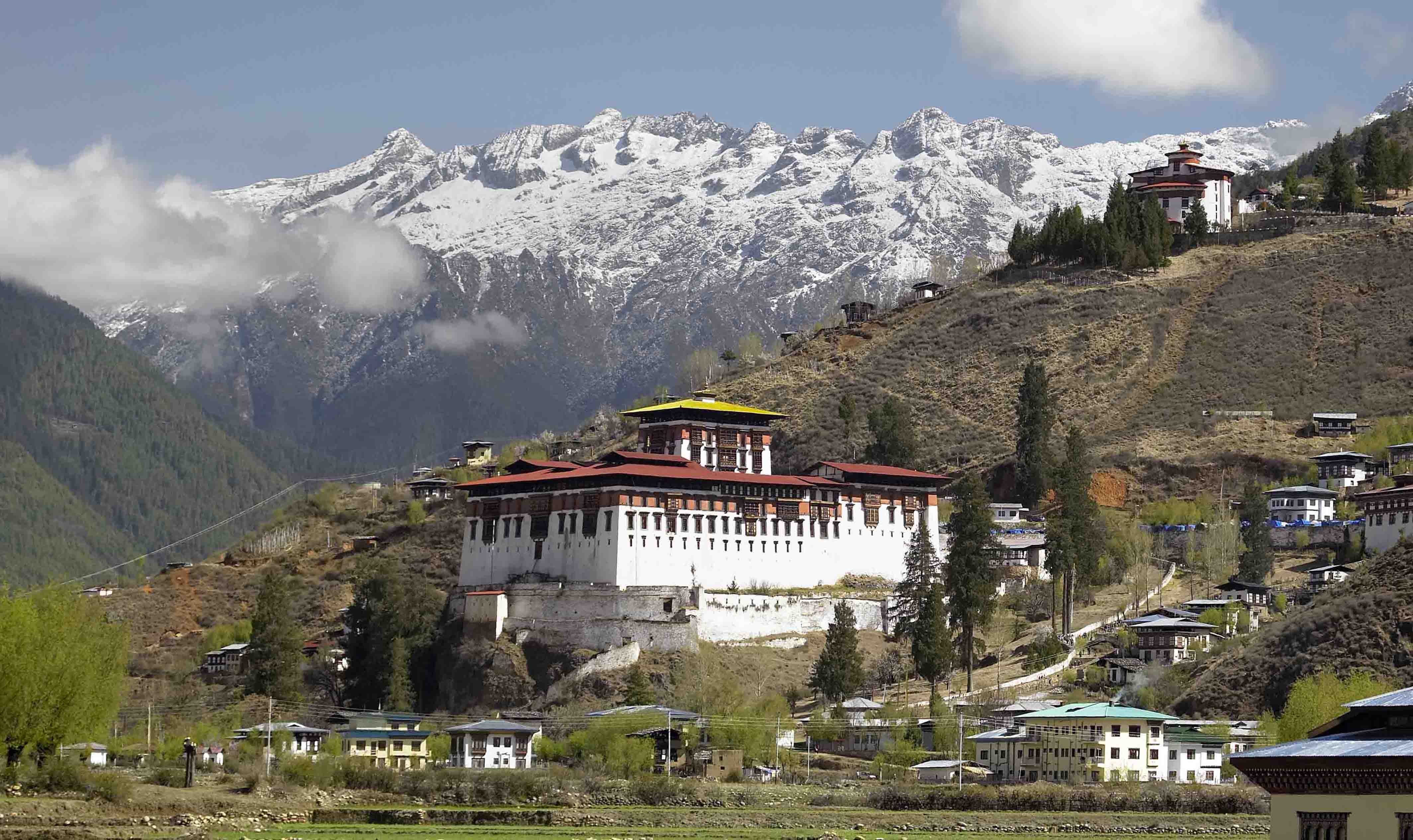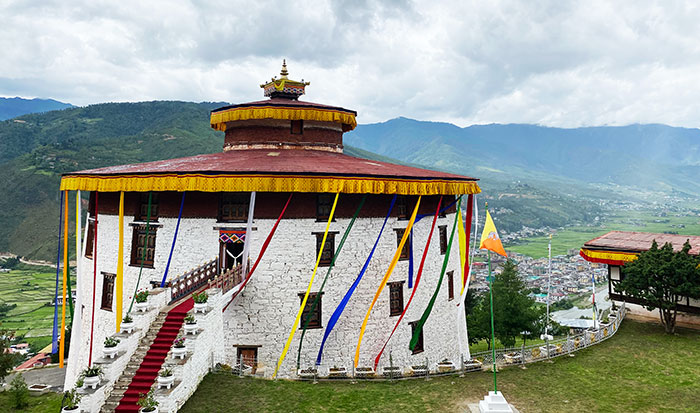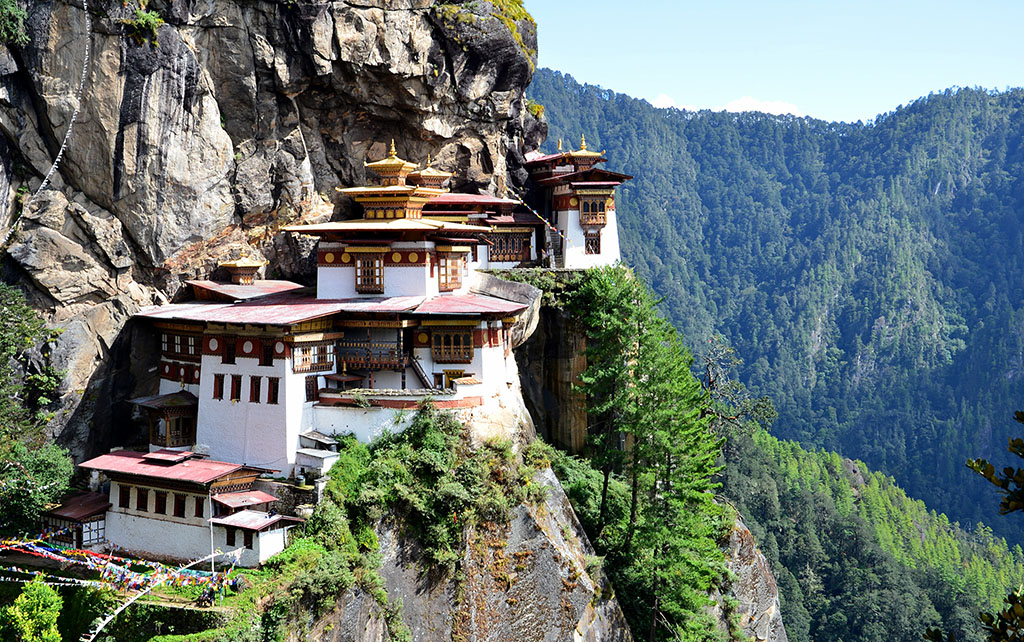
· Picturesque Paro
The valley extends from the confluence of the rivers at Chuzom right up to Mt. Jumolhari at the Tibetan border in the North. But what accentuates the beauty of the region are the many traditional style houses that dot the valley and surrounding hills making Paro one of the best Bhutanese towns to explore on foot at the end of a day of sightseeing.And because Bhutan’s international airport is located here, it is the only port of arrival and departure by air for international tourists, and so, the valley is adorned by luxurious and boutique hotels and resorts to suit every budget.
1. Paro Dzong (Rinpung Dzong):

The Rinchen Pung Dzong or Rinpung Dzong translates to ‘Fortress on a Heap of Jewels’ and is the finest illustration of Bhutanese architecture and craftsmanship you’ll see. So impressive it is that even Bernardo Bertolucci filmed scenes of his 1995 film Little Buddha here.
In 1644, Zhabdrung Ngawang Namgyal (the unifier of Bhutan) ordered the construction of the dzong on the foundation of a monastery built at the beginning of the tenth century by Padma Sambhava. The imposing fort served effectively to defend the Paro valley against numerous Tibetan invasions. So much so that British political officer John Claude reported that in 1905 there were old catapults still in the rafters of the dzong’s verandah for throwing massive boulders at the invading army.
In the first day of spring, the Paro Tshechu is held in the dzong courtyard – which is filled to the brim. To the northeast of the entrance, is a stone-paved area where masked dancers perform the main dances of the tsechu. A thondrol or a huge thangka of Guru Rinpoche, more than 18m square, is unfurled shortly after dawn on the final day of the festival. The Paro tshechu was commissioned in the 18th century by the eighth Desi (secular ruler of Bhutan) and it continues be a major draw for locals and tourists even today.
Below the dzong, a traditional wooden covered bridge called Nyamai Zam spans the Paro Chhu. This is a reconstruction of the original bridge, which was washed away in a flood in 1969. Earlier versions of this bridge were removed in time of war to protect the dzong. The most picturesque pictures of Paro Dzong are taken from the west bank of the river, just downstream from the bridge.
2. The National Museum:

Atop the hill above the Paro Dzong is an old watchtower called Ta Dzong. The unusual building in the shape of a conch shell, with 2.5 m-thick walls was completed in 1656. But, it wasn’t until 1967 that the structure was renovated to house the National Museum.
Cameras are not allowed inside the museum, but one can photograph the dzong from outside along with its surrounding areas. There are various galleries inside and the displays include an impressive collection of thangkas, both ancient and modern, depicting Bhutan’s important saints and teachers, as well as formidable festival masks. There’s a heritage gallery that displays a collection of religious statues and early stone carvings, plus a few original iron links from the nearby Tamchhog Bridge.
Driving to the museum involves a 4 km loop into the scenic Dop Shari valley. And once you get there, you can enjoy the magnificent view of the Ugyen Pelri Palace that stands across a medieval bridge below the dzong. It is said that there is an underground tunnel from the watchtower leading to the palace.
3. Tiger’s Nest (Taktsang):

A 10km drive from Paro is the famous Tiger’s Nest Hermitage on the face of a sheer 3,120m-tall cliff. The Tiger’s Nest or Taktsang Monastery is without a doubt the most visited and the most photographed of all the monuments in Bhutan. Nestled above a beautiful forest of blue pine and rhododendrons, overlooking the Paro valley, the monastery is of tremendous religious significance to the Bhutanese. Legend has it that Guru Rinpoche flew to this site on the back of a tigress to subdue a local demon and it was here that Buddhism took roots in Bhutan. The monastery was built in 1692 to honor and worship the Guru. The hike up to the Tiger’s Nest is give-or-take a two-hour ascent and, the view from the top, is well worth the climb.
4. Drugyel Dzong:

Another site worth visiting while in Paro is Drugyel dzong or The Fortress of the Victorious Bhutanese. A 16km road passes up the valley to the ruins of this fortress-monastery, which was partly destroyed by fire in 1951. And although the fortress – built by Zhabdrung Ngawang Namgyal in 1646 to commemorate his victory over raiding and pillaging Tibetan armies – was raged by the fire, the ruins remain an impressive and imposing sight still.
5. Tamchog Monastery:
This Monastery is the only temple in Bhutan that is dedicated to the 13th century saint Thangthong Gyalpo, also known as the bridge builder. Located across the river on the Thimphu-Paro highway, one must traverse through an iron chain bridge in order to get to the monastery. The bridge is one of the few remaining of the many that Thangthong Gyalpo built in his time.
The swaying of the old iron bridge for most visitors can be quite an experience before getting to the monastery that is located on a ridge high up on rocky hills.
6. Dungtse Lhakhang:
Dumgtseg Lhakhang is a sacred temple built in the form of a chorten in Jangtsa, Paro.
Located on the edge of a hill between Paro and Dopchari valley, across the bridge from Paro town, the temple was built by the saint Thangtong Gyalpo. The Buddhist iconography depicted in the Chorten is considered a unique repository of the Drukpa Kagyu School. While one story goes that the Lhakhang was built to subdue an evil serpentine force. Another story says that the Lhakhang was built on the head of a demoness.
7. Kichu Monastery:
By far, Kichu Lhakhang is one of Bhutan’s oldest monasteries. King Songtsen Gampo of Tibet built it in 659. Legend goes that the King built it to overpower the left foot of a giant ogress that was thwarting the establishment of Buddhism in Tibet. Pilgrims circumambulate around the temple spinning its many prayer wheels, seeking blessings and offering prayers.
Upon entering the inner courtyard you’ll see a mural to the right of the doorway of King Gesar of Ling, the popular Tibetan warrior-king, whose epic poem is said to be the world’s longest.
8. Kila Goemba:
Kila Nunnery is among the most reputed and oldest nunneries in Bhutan. It was established as a meditation site in the 9th century. Located on the Paro-Haa Highway, the nunnery can be reached via a farm road. At present, there are around 50 nuns pursuing their Buddhist studies there. The striking feature of the goemba is the series of nunneries that are built intricately against the cliffs. The nunnery can also be reached from Chelela pass, traversing through chortens, prayer flags and a scenic stretch of flora and fauna. The hike takes approximately one hour.
9. Dzongdrakha Monastery:
Dzongdrakha Goempa is often called the mini Taktsang monastery as it is built on a cliff face in the village of Bondey in Paro. As such, Dzongdrakha literally translates into the ‘Temple on a cliff’. To get there, it takes about 20 minutes by car from Paro town. Located at an altitude of 2227 meters, the temple was built in the 16th century. It is one of the many places m Guru Rinpoche meditated in.
10. Bumdra Monastery Hike
This hike is an overnight trek that is highly recommended. It provides a great view of the Paro valley. Hikers can soak in the gorgeous sunsets over the mountains of Haa. It also provides for an interesting cliff-face pilgrimage site, and one can look at all the chapels above Taktshang Goemba, not to forget the spectacular view it offers of the Tiger’s Nest Monastery. For the adventurous, the trail can also double as an excursion to a sky burial site.
The camping accommodation at Bumdrak is the most luxurious in Bhutan. To get to the camping site is an uphill battle on the first day. The second day, however, you’ll be going downhill. Please note that this trek requires one to be in decent shape to enjoy it.

No comments:
Post a Comment